Thanks to new technology, video conferencing has become a standard for many small businesses. It makes it easier to connect with clients and employees around the world, means less travelling, and more savings. But the truth is, making sure everything runs smoothly is easier said than done. From dressing the part to testing the equipment, here are 10 tips that will make your next video conference a huge success.

- Set an agenda
Just like face-to-face meetings, video conferences need an agenda. So if you’re the one running the show, make sure you have a clear set of objectives and share these around before the meeting. Getting lost in the technical side of things can be all too easy, but having a plan will keep the conference on track. At the end of the day, the aim is to be productive.
- Dress to impress
It can be tempting to relax a little in video conferences. People usually only see you from the waist up. But it’s important to keep up appearances – you never know if you’ll have to stand up or where the camera might fall. So what should you wear? Keep it simple and professional. Try to avoid bold and busy patterns, bright or overly dark colours. Instead, go with lighter shades or muted colours. You want people to focus on what you’re saying, not what you’re wearing.
- Position the camera (and the people)
Bad camera angles can be distracting, not to mention unflattering. Whether you’re connecting from a conference room or from the office, make sure the camera is positioned at eye level – not too high and not too low.
In conference rooms, you’ll also have to work out where the facilitator and participants will sit. Before the meeting takes place, take time to rearrange the chairs so that everyone can be properly seen on camera. Whoever is leading the meeting will usually sit at the end of the table.
- Know your tools
Today’s technology might make video conferencing a breeze, but let’s face it – things can go wrong. Whether you’re using your own machine or a larger conference room, give yourself at least 45 minutes to test your equipment. Make sure the microphones are working, the audio is at the right level, and most importantly, that everyone can see the visuals. If you’re using PowerPoint or video clips, it’s worth doing a test run. Nothing is more frustrating than having to stop the meeting because of ‘technical difficulties.’
- Be aware of body language
Sometimes it’s easy to forget you’re on camera. This is natural, especially if you’re not used to video conferences. Just make sure you sit up straight and always maintain eye contact with the speaker. The aim is to look and feel engaged, so be mindful of moving your body too much and remember to smile. Also, try to avoid any habits like tapping your pen, drumming your fingers, or slouching in your chair.
- Talk the talk
When it’s your turn to talk, the first thing you should do is introduce yourself. Make sure you speak straight into the microphone and try not to move your head around too much; otherwise, your voice will fade in and out. The sound should already be adjusted to the right level, which means you won’t need to speak louder than usual. That said, be mindful that even the smallest noises will be picked up – whispering, paper rustling, and coughing. While you won’t have to speak louder, it’s worth slowing your pace down a little, just to account for any slight delays over long distances.
- Check your connection
This goes without saying. A bad Internet connection equals a frustrating video conference. So before you do anything, check that your connection is up to speed. If you find that it’s a little on the slow side, it could be for a number of reasons. To quicken things up, try resetting the router, shutting down unnecessary programs, or checking for viruses. If this doesn’t work, it’s probably time to get in touch with your provider or change connections.
- Minimise distractions
These days, it feels normal to whip out your smartphone or laptop wherever you are. But when it comes to video conferences, this can cause tension. Unless it’s absolutely necessary, it can be a great idea to establish a ‘no devices’ policy. Getting back to the basics, like using a pen and paper, is both quieter and often more efficient – no rings, alarms, buzzing, or loud typing.
Art and decorations should also be kept professional, clean and inoffensive.
- Light it up
The last thing you want is that feeling of talking to someone in a dungeon. That’s why lighting is so important. If possible, let natural light flow in from the windows. If this makes for too much glare or the lighting is uneven, pull down some shades or simply turn on the overhead lights.
- De-clutter the room
Usually, the entire room you’re in will be visible to all viewers. Like with what you wear, where you are should be clean, neat and professional. This means getting rid of background boxes, food wrappers, coffee mugs and anything else that draws attention away from you. Think of it like a stage performance – you’re on show and everything in the room serves a purpose.





















